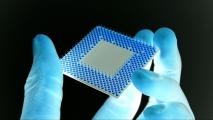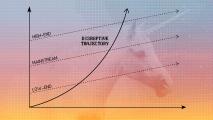A team at the University of Washington is developing a way to turn your smartphone into a thermometer. If it works, it could put a helpful diagnostic device in your pocket, ready for use at any time.
Dubbed FeverPhone, the application doesn’t require any extra hardware. Instead, it takes advantage of heat sensors called thermistors, which are present in both common digital thermometers and smartphones. By holding their phone to their foreheads with the screen making contact, users were able to get a reading of their temperature. When tested on 37 patients in the ER, FeverPhone was able to measure temperatures with an accuracy comparable to some commercial thermometers.
“In undergrad, I was doing research in a lab where we wanted to show that you could use the temperature sensor in a smartphone to measure air temperature,” Joseph Breda, a doctoral student at UW’s Paul G. Allen School of Computer Science & Engineering, said.
Researchers are developing a way to turn your smartphone into a thermometer. If it works, it could put a helpful diagnostic device in your pocket, ready for use at any time.
Breda and his advisor decided to investigate if that research could be turned towards health, settling on using the phone’s thermistors to read for fever.
“We decided to measure fever in an accessible way,” Breda said. “The primary concern with temperature isn’t that it’s a difficult signal to measure; it’s just that people don’t have thermometers.”
Heating up: Diagnosing fevers is a useful public health tool; heating up is often a sign of infection. An oral reading of over 100℉ is considered the clinical threshold, and while a fever per se is generally not a cause for alarm, even a low fever can be trouble for infants. Readings of 103℉ and up mean it’s time to seek help for adults.
The ability to measure your temperature without a thermometer may help better inform treatment, as well as outbreak response.
“People come to the ER all the time saying, ‘I think I was running a fever.’ And that’s very different than saying ‘I was running a fever,’” study co-author and UW clinical instructor Mastafa Springston said.
“So if people were to share fever results with public health agencies through the app, similar to how we signed up for COVID exposure warnings, this earlier sign could help us intervene much sooner.”
How it works: For their study (published in the snappily-named “Proceedings of the ACM on Interactive, Mobile, Wearable and Ubiquitous Technologies”), the team harnessed the thermistors already in smartphones, which are primarily used for measuring battery temperature.
The team realized those thermistors, when combined with a phone screen’s ability to measure skin-to-screen contact, could be used to figure out the temperature of the user’s body.
By reading the air temperature and adjusting for the difference when the phone is in contact with skin, the thermistors can measure how warm the person’s body is. The app uses the thermistors to track how fast the phone heats up, then uses the screen’s sensors to measure how much of that increase is coming from the person.
The app takes advantage of heat sensors called thermistors that are already in the phone, mainly for keeping tabs on battery temperature.
To develop FeverPhone, the team started with bags of water, heated with a sous-vide machine, to simulate a forehead. The team pressed phones against the bags to get their temperature; three different models were used, as well as an array of accessories, like screen protectors and cases, to help control for people’s personal phone set-ups.
That data was fed into a machine learning AI to develop the body temp-sensing algorithm.
FeverPhone was then tested in a small clinical trial of 37 patients, 16 of whom had a mild fever, at the UW School of Medicine’s Emergency Department.
Patients held the phone to their forehead — fingers on the corners, to minimize heat coming from the hands — for ~90 seconds. FeverPhone measured core body temperature with an average error of .41℉, within the clinically acceptable limit of .5℉.
“We found that FeverPhone’s temperature estimates are comparable to commercial off-the-shelf peripheral and tympanic [ear] thermometers,” the team wrote in their paper.
There’s a few caveats, beyond the small sample size. Patients with severe fevers of over 101.5℉ were left out of the trial, because the sweat on their skin interferes with the touchscreen’s data. The test was also run on only three different kinds of phones.
By reading the air temperature and adjusting for the difference when the phone is in contact with skin, the thermistors can measure how warm the person’s body is.
Next steps: FeverPhone’s not yet ready for prime time, the team says; more data will be needed to hone the model and to make sure it works on the sundry devices out there — including smartwatches and other wearables.
“We started with smartphones since they’re ubiquitous and easy to get data from,” Breda said. Smartwatches would be ideal, however, because their smaller size makes the temperature difference more dramatic.
“So you could imagine having a user put a Fitbit to their forehead and measure in 10 seconds whether they have a fever or not,” Breda said.
We’d love to hear from you! If you have a comment about this article or if you have a tip for a future Freethink story, please email us at [email protected].






